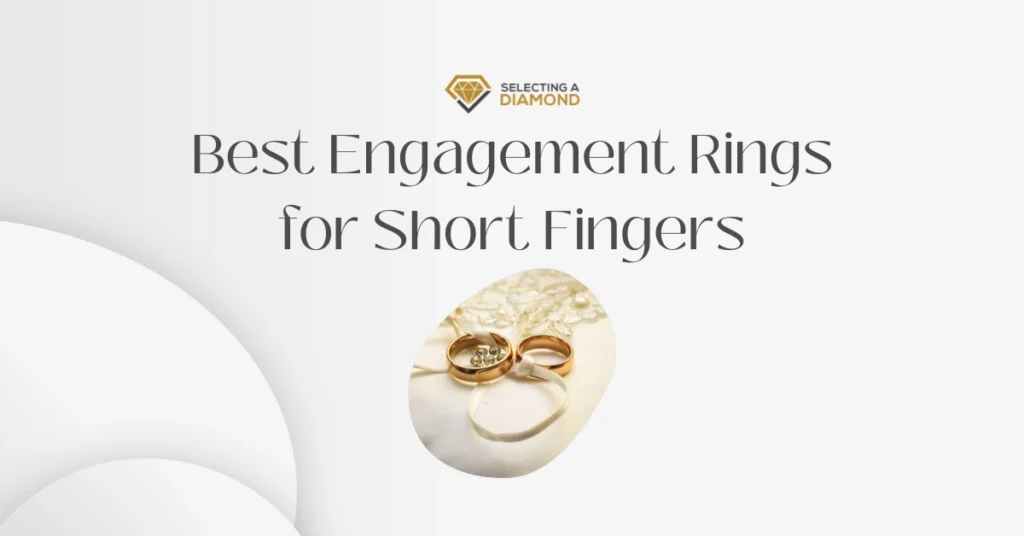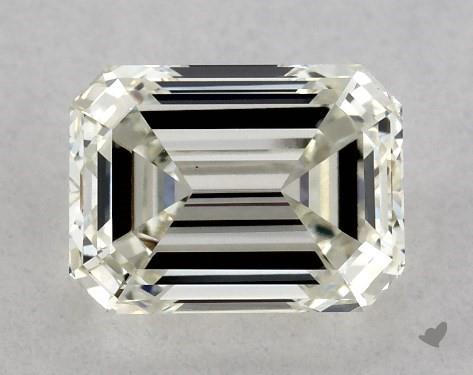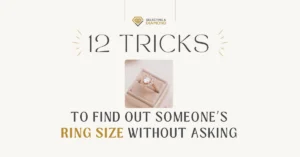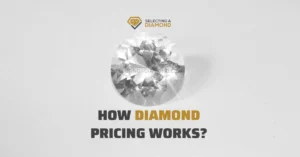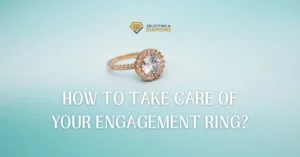We may earn a commission when you purchase through our affiliate links, at no extra cost to you. This helps support our work and allows us to continue providing unbiased, expert diamond advice.
You don’t need to feel anxious or insecure about your hands when you’re buying a wedding ring.
Making the right choice and finding what’s best engagement rings for short fingers what makes all the difference.
That’s how life works in every decision, we are all different and no one size or style fits everyone, we are not robots or machines, we’re humans, just find what works best for you and you will be shining like no one else.
So in this guide, we’ll help you find what works best for your short hands.
Let’s go.
What to Look for for Your Hand
It’s important to consider both the length and the proportion of the fingers about the size of the hand. Generally, a short finger appears shorter in proportion to the width of the palm and the other fingers. The look of finger length is also influenced by the size and shape of the nail.
When considering engagement rings for shorter fingers, the goal is often to create the illusion of length. Rings with certain types of settings and band styles can visually elongate the appearance of the finger.
For example, vertical setting styles, such as marquise, oval, or rectangular with rounded corners, can make short fingers appear more slender and longer. Narrower bands contribute to this effect as well, as they create less coverage over the skin, allowing more of the finger to be visible, thus enhancing the perception of length.
In contrast, wide bands and horizontal settings, such as wide rectangular shapes, can make fingers appear shorter because they cover more of the finger and can make it look stubbier.
Understanding the visual impact of ring styles on finger proportions is key to selecting the best engagement ring for shorter fingers. The aim is to complement the natural beauty of the hand while creating a harmonious balance between the ring and the wearer’s finger shape and size.
Elements of the Engagement Ring for Short Fingers
When selecting an engagement ring for someone with short fingers, every element of the ring can play a role in enhancing the hand’s appearance. Understanding how to balance these elements is essential in creating a flattering look. Here are the elements to consider:
The Ring Shank
The shank, or the band of the ring, should be proportionate to the finger. For short fingers, a thinner shank can help elongate the appearance of the finger. A split shank can also give the illusion of a wider, more elegant hand without overpowering the finger.
Stones
The choice of stone and how it is set can have a significant impact. Elongated stones such as oval, marquise, or pear shapes can help make the fingers appear longer. A vertically set stone draws the eye up and down, enhancing the length of the finger.
Metal
The color of the metal can also play a role. For instance, cooler metals like white gold or platinum can make the band appear less noticeable, hence making the finger seem longer. Warmer metals, like rose or yellow gold, draw attention to the ring itself and can be used to complement the skin tone.
Bands
When it comes to the bands, those with short fingers might want to avoid overly embellished bands or multiple stacked bands, as they can overwhelm the finger. A single, delicate band with a vertical row of diamonds or other gemstones can provide a lengthening effect.
Stone Shapes Ideal for Engagement Rings on Short Fingers
Choosing the right stone shape is crucial for enhancing the natural beauty of short fingers.
The emerald cut is a rectangular shape with cut corners and is known for its long, lean lines. Its elongated silhouette can help to create the illusion of length on a shorter finger. The emerald cut’s step facets also emphasize the stone’s clarity, offering a sophisticated, elegant appeal.
Oval stones are very versatile and can be set to run along the finger in a narrow design. A narrow oval cut provides the benefits of an elongated stone without the width that might otherwise shorten the appearance of the finger. This shape can also make the finger appear slimmer and longer due to its stretched outline.
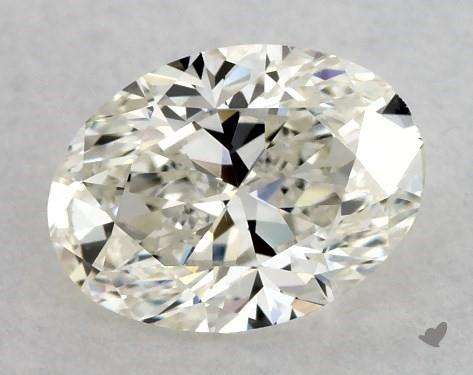
The pear shape, also known as a teardrop, combines elements of both the oval and marquise cuts with a rounded end and a pointed tip. When worn with the point facing the nail, it can make the finger appear more elongated and elegant, providing a unique and flattering look.
With its elongated shape and pointed ends, the marquise cut is particularly effective in lengthening the appearance of short fingers. Its distinctive football shape maximizes carat weight, giving the illusion of a larger stone, which also contributes to the perception of a longer finger.
Best Ring Settings Ideal for Short Hands
The setting of an engagement ring is the framework that holds the stones and connects them to the band, and like the right frame for a painting, the perfect setting can accentuate the beauty of the ring and the hand-wearing it.
Imagine a ring that tells a tale of time — the past, present, and future — through its stones. This is the essence of a setting that hosts a trio of gems, typically with the central stone slightly larger, and flanked by two smaller companions. This linear arrangement leads the gaze across the finger, offering an illusion of length without overwhelming the hand’s petite proportions.
Now, let’s consider a setting that brings a contemporary flair: the split shoulders. This design divides the band as it nears the center stone, creating a graceful space that lends an airy elegance to the ring. The split can be simple or elaborate, but it always adds a visual interest that enhances the finger’s length subtly and stylishly.
Flowing from the modern to the romantic, the two-stone setting, often symbolic of two hearts in unison, positions a pair of stones in a close dance. When these stones align along the finger’s length, they create a gentle stretch that can visually extend the hand. This setting isn’t just an emblem of togetherness; it’s a clever ally to the aesthetics of short fingers.
And lastly, we come to a setting that borrows from the luxurious and ornate era of Art Deco. In this variant of the split shoulder design, geometric patterns and symmetrical lines recall the opulence of a bygone time. It’s a setting that combines intricacy with the ability to elongate the finger, a testament to how a nod to the past can beautifully complement the present.
As we consider each set in succession, they are not standalone choices but part of a cohesive narrative. Each setting builds upon the last, offering unique advantages to the wearer, ensuring that the final selection is not just a ring, but a piece of personal artistry that complements the hand’s natural elegance.
Best Metals for Engagement Rings for Short Fingers
Continuing our journey through the artful selection of engagement rings for short fingers, we now turn our attention to the bands and metals that form the foundation of the ring. These elements are just as crucial as the stone and setting in achieving a flattering look.
Bands:
The band of the ring is the circle of continuity, a symbol of unending love. For short fingers, the ideal band is slender and delicate, allowing more of the finger to be seen, which in turn gives an elongated effect. Bands with a slight taper towards the stone can accentuate this lengthening effect even further. Consider bands that are smooth and unadorned, or those with a row of small, pavé-set diamonds to add a touch of sparkle without shortening the appearance of the finger.
As we gracefully transition from bands to metals, remember that the color and finish of the metal can also influence the perception of the ring’s proportions.
Metals:
The metal encasing the gemstone is the unsung hero of the ring’s design, its color and sheen playing a supporting role to the stone’s lead. For short fingers, the brightness of white gold or platinum can be especially flattering, as these metals draw less attention to the band and more to the stone, contributing to the elongating effect. For those with warmer skin tones, rose gold can provide a soft, flattering contrast, and yellow gold can bring a classic warmth that enhances without overpowering.
When bands and metals are chosen with care, they create an elegant frame for the ring’s centerpiece, complementing the stone and setting in a harmonious balance. The metal’s hue and the band’s design are like the finishing strokes of an artist’s brush, bringing the entire piece into focus. Each element should be considered a part of a greater whole, with the ultimate goal of highlighting the beauty of the wearer’s hand.
In summary, the selection of the band and metal for an engagement ring should be a thoughtful process, considering the overall aesthetic and how each component interacts to produce the most flattering effect for short fingers. The band should be a whisper, not a shout, allowing the stone to sing, and the metal should act as a perfect pitch, enhancing the melody of the design.
Conclusion
You don’t need to worry that your hands aren’t pretty, that’s a purely subjective opinion, no one has a definition book of what’s pretty and what is not.
You need to make the right choices, choices that fit you and fit your situation, that’s how life works in every aspect you could imagine.
Remember, we’re not robots, we’re not machines, and there are no ‘standards’. Just pick what works best for you and everyone will be amazed at your look.

